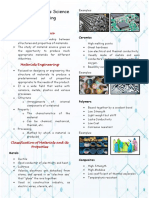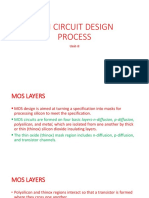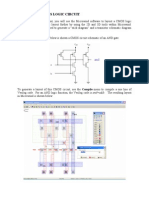Custom Integrated Circuit Design Using Open-Source Tools
Uploaded by
Complex Systems Modeling and EngineeringCustom Integrated Circuit Design Using Open-Source Tools
Uploaded by
Complex Systems Modeling and EngineeringIntegrated Circuit Design Using
Open-Source Tools
Dylan Grace, Jeremy Blumka, Joel Reuning-Scherer, Larissa Ptak, Philip Wig, Adviser: Dan White, Ph.D.
Abstract The Analog Design Process
Our team is exploring open-source tools for Very Large-Scale Integration (VLSI) Unlike the highly automated digital flow, analog design using the SkyWater PDK is a
design, used in the design of computer chips. In the past, most tools for chip design manual process. Within an analog design, each transistor needs to be individually
have been proprietary. We are exploring using open-source tools for both analog and sized and designed.
digital VLSI design. By furthering our understanding of these tools, we aim to make
VLSI design accessible to a broader market of people, in order to aid in education by The analog design process can be generalized as follows:
removing the barriers to learning about integrated circuit design. This will allow for not • Define system requirements/constraints, such as power consumption, accuracy
just theoretical education but also practical experience in the chip design field for tolerances, etc.
undergraduate students. • Determine the system architecture, based on performance constraints
• Specify transistor characteristics for each transistor in the design
The Importance of Approachability • Simulate the design to verify functionality
• Finalize the physical layout of the design for tape-out
In order to produce a functional chip, one needs a sound understanding of architecture
design, basic logic design, logic verification, physical design layout, physical design For our designs, Xschem was used for schematic design, Ngspice was used for
verification, fabrication, and testing. The wider availability of an open-source design simulations, and Magic or KLayout was used for the physical layout. Design Rule
flow ultimately will produce more competent and capable engineers with more diverse Checking (DRC) was performed in Magic and Layout Versus Schematic (LVS)
backgrounds. By testing and documenting our process with an open-source design checking was done using Netgen.
flow, we are increasing awareness and availability of the chip design process.
The Digital Design Process
Most modern devices are digital systems due to their deterministic behavior. The
digital design process is far more streamlined than its analog counterpart, as software
tools exist to implement hardware behavior via standard cells. Due to the simplicity in Figure 3: Custom Arithmetic Logic Unit (ALU) made with OpenLane. This custom ALU
the digital design process, digital systems can be much more complex than analog is 80.685 microns wide and 91.405 microns tall.
systems.
The digital design process can be generalized as follows:
• Define system requirements/constraints, such as minimum clock speed, target power
consumption, or desired inputs and outputs
• Determine the system architecture based on design constraints
• Implement the system in a hardware description language (Verilog)
• Simulate and validate input and output waveforms (Icarus Verilog, GTKWave,
Ngspice, Quartus ModelSim)
• Procedurally generate a floorplan of the system (OpenLane) using standardized cells
(SkyWater PDK, Efabless Caravel) Figure 6: Two-stage operational amplifier, designed in Xschem.
• Verify and finalize the physical layout of the design for tape-out (OpenLane, KLayout,
Magic, Ngspice), including integration with Caravel
Figure 4: The OpenLane design flow [3].
Figure 1 (above): And2 standard cell Figure 7: Frequency response plot of the operational amplifier shown in Figure 6, simulated
from SkyWater PDK [1]. with Ngspice and plotted using Python and the Matplotlib library.
Figure 2 (right): The Efabless
Caravel harness. Actual size is 3.6mm
References:
x 5.2mm. The entirety of the ALU [1] Google. (2022). SkyWater Open Source PDK. GitHub Repository. Available:
https://github.com/google/skywater-pdk
depicted in Figure 3 fits within the [2] Efabless. (2022). Caravel Harness. GitHub Repository. Available:
https://github.com/efabless/caravel
black region in the center [2]. [3] Ghazy, A., & Shalan, M. (2020). OpenLANE: The open-source digital ASIC implementation flow.
Presented at Workshop on Open-Source EDA Technol. (WOSET). [PDF]. Available:
https://github.com/woset-workshop/woset-
Figure 5: Layout for a two stage Miller compensated operational amplifier using workshop.github.io/blob/f2171edef70cf2fb5a87666554873a6a77eaa2c6/PDFs/2020/a21.pdf
[4] Hernando, D. (2021). Caravel_fulgor_opamp. GitHub Repository. Available:
KLayout [4]. https://github.com/diegohernando/caravel_fulgor_opamp
You might also like
- DanceEvolution Arcade 2021 Windows 10 GuideNo ratings yetDanceEvolution Arcade 2021 Windows 10 Guide18 pages
- Age of Ashes 1 - Hellknight Hill Pages 1-50 - Flip PDF0% (1)Age of Ashes 1 - Hellknight Hill Pages 1-50 - Flip PDF100 pages
- Once You Upload An Approved Document, You Will Be Able To Download The Document Lippincott Pharmacology 5th Edition PDFNo ratings yetOnce You Upload An Approved Document, You Will Be Able To Download The Document Lippincott Pharmacology 5th Edition PDF1 page
- Design Considerations For BJT-Based Overvoltage Protection CircuitNo ratings yetDesign Considerations For BJT-Based Overvoltage Protection Circuit4 pages
- Batangas State University College of Engineering, Architecture & Fine ArtsNo ratings yetBatangas State University College of Engineering, Architecture & Fine Arts9 pages
- Self-Sufficient Guide To Electronics Engineering by JASON AMPOLOQUIONo ratings yetSelf-Sufficient Guide To Electronics Engineering by JASON AMPOLOQUIO14 pages
- Unit 4 - Materials Science and Engineering PDFNo ratings yetUnit 4 - Materials Science and Engineering PDF2 pages
- Adamson University College of Engineering Computer Engineering Department Microelectronics LaboratoryNo ratings yetAdamson University College of Engineering Computer Engineering Department Microelectronics Laboratory9 pages
- Wireless Module - Microwave PropagationNo ratings yetWireless Module - Microwave Propagation58 pages
- The Shortest Distance and Length of The Stub Connected Shunt From The Load in Wavelengths?No ratings yetThe Shortest Distance and Length of The Stub Connected Shunt From The Load in Wavelengths?3 pages
- Signals, Spectra, Signal Processing ECE 401: Table ofNo ratings yetSignals, Spectra, Signal Processing ECE 401: Table of1 page
- Complete The Table Below by Varying The Width of The PMOS Transistor. Round Off Your Answers To Two Decimal PlacesNo ratings yetComplete The Table Below by Varying The Width of The PMOS Transistor. Round Off Your Answers To Two Decimal Places3 pages
- The Mosfet: Computer Engineering Department Adamson UniversityNo ratings yetThe Mosfet: Computer Engineering Department Adamson University44 pages
- Lab Cruise Control - Modeling Part2 PDFNo ratings yetLab Cruise Control - Modeling Part2 PDF10 pages
- Lesson No.1.PHYSICS FOR ENGINEERS - Introduction and Sample Problems - APRIL2021No ratings yetLesson No.1.PHYSICS FOR ENGINEERS - Introduction and Sample Problems - APRIL20212 pages
- RALPH JAN AQUINO Control System SummaryNo ratings yetRALPH JAN AQUINO Control System Summary13 pages
- Resistor-Transistor Logic (RTL) CircuitsNo ratings yetResistor-Transistor Logic (RTL) Circuits7 pages
- Control Systems Laboratory Experiment 4 Open-Loop vs. Closed-Loop Control SystemsNo ratings yetControl Systems Laboratory Experiment 4 Open-Loop vs. Closed-Loop Control Systems6 pages
- Antenna Azimuth Position Control System Verification100% (1)Antenna Azimuth Position Control System Verification4 pages
- LESSON - 2 - Important Points About SignalsNo ratings yetLESSON - 2 - Important Points About Signals13 pages
- Feedback and Control Systems: Activity No. 2 - Time Response of Dynamic SystemsNo ratings yetFeedback and Control Systems: Activity No. 2 - Time Response of Dynamic Systems15 pages
- EE2003 Semiconductor Fundamentals - OBTLNo ratings yetEE2003 Semiconductor Fundamentals - OBTL6 pages
- Sagnac Interferometer: Theory & Background: 5.1 Introduction To Sagnac InterferometersNo ratings yetSagnac Interferometer: Theory & Background: 5.1 Introduction To Sagnac Interferometers15 pages
- Princom Fundamentals of Frequency ModulationNo ratings yetPrincom Fundamentals of Frequency Modulation5 pages
- ECE 027 - Module 1 - Introduction About Semiconductor DiodesNo ratings yetECE 027 - Module 1 - Introduction About Semiconductor Diodes54 pages
- Classifications of Signals: ECE 593: Signal, Spectra and Signal Processing Course OutlineNo ratings yetClassifications of Signals: ECE 593: Signal, Spectra and Signal Processing Course Outline6 pages
- Experiment No. 05: Simulate I-V Characteristics of PN and Zener Diode Using LtspiceNo ratings yetExperiment No. 05: Simulate I-V Characteristics of PN and Zener Diode Using Ltspice10 pages
- Silica Optical Fiber Technology for Devices and Components: Design, Fabrication, and International StandardsFrom EverandSilica Optical Fiber Technology for Devices and Components: Design, Fabrication, and International StandardsNo ratings yet
- Optical and Microwave Technologies for Telecommunication NetworksFrom EverandOptical and Microwave Technologies for Telecommunication NetworksNo ratings yet
- Professor Chris Chatwin: Msc/Meng - Satellite and Space SystemsNo ratings yetProfessor Chris Chatwin: Msc/Meng - Satellite and Space Systems110 pages
- T-11 Capstone Project Report: Group No: B43 Project Guide: Prof. Vinayak Musale Group Members SR No Name PRN NoNo ratings yetT-11 Capstone Project Report: Group No: B43 Project Guide: Prof. Vinayak Musale Group Members SR No Name PRN No16 pages
- Oracle Global Human Resources Cloud 2017 Implementation Essentials v5.0No ratings yetOracle Global Human Resources Cloud 2017 Implementation Essentials v5.07 pages
- Top 5 Ways Amazon Uses CRM 1. Tailored Offers and PromotionsNo ratings yetTop 5 Ways Amazon Uses CRM 1. Tailored Offers and Promotions3 pages
- Mall Customer Segmentation Using ClusterNo ratings yetMall Customer Segmentation Using Cluster6 pages
- Advantys STB Distributed I/O Solution: Selection GuideNo ratings yetAdvantys STB Distributed I/O Solution: Selection Guide1 page
- Middle Ear Analyzer: Diagnostic & Clinical Tympanometry With Basic AudiometryNo ratings yetMiddle Ear Analyzer: Diagnostic & Clinical Tympanometry With Basic Audiometry8 pages
- Writing Good Requirements - Ivy Hooks - 1993No ratings yetWriting Good Requirements - Ivy Hooks - 199311 pages
- To Make Table, Queries, Forms & Reports in MS Access 2007No ratings yetTo Make Table, Queries, Forms & Reports in MS Access 200711 pages
- Xenyx X2442usb / X2222usb X1832usb / X1622usb X1222usb / X1204usb / 1204usbNo ratings yetXenyx X2442usb / X2222usb X1832usb / X1622usb X1222usb / X1204usb / 1204usb17 pages
- Baking Ambient Occlusion (Transfer Map Method)No ratings yetBaking Ambient Occlusion (Transfer Map Method)11 pages
- Design and Implementation of A Collaborative Freelancers' Sourcing PlatformNo ratings yetDesign and Implementation of A Collaborative Freelancers' Sourcing Platform21 pages





























































































